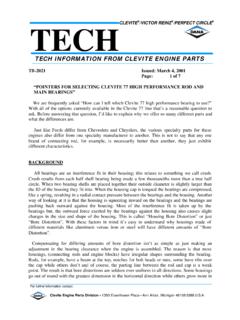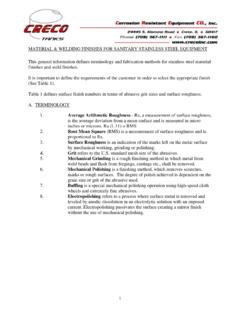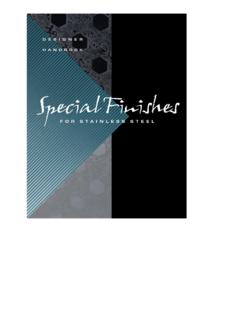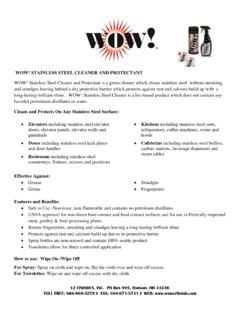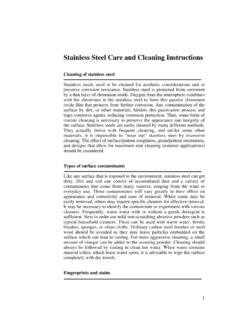Transcription of Stainless Steel – Surface Finishes - Stealth 316
1 1. Stainless Steel Surface Finishes Introduction Finishes and Fabrication Surface finish is an important element in any Some fabrication operations, such as grinding specification of Stainless Steel regardless of the prior to painting or gluing, may require a rough intended use. For those applications where Surface finish but, generally speaking, a appearance is important, finish is a design smooth, well finished sheet requires less element and must be specified. In non- physical effort than a coarse, rough one when it decorative applications the Surface finish may comes to blending. Certain Finishes are more have implications for friction, wear, difficult to recreate by hand than others, maintenance or corrosion resistance and must, causing fabrication difficulties; this is especially therefore, also be carefully chosen and clearly true of the special Finishes which cannot be specified.
2 Easily replicated in a fabrications workshop. For The choice of finish should never be left to the this reason the fine satin finish (such as supplier, or the specification loosely worded, OPTISHEEN ) is popular and practical for such as Type 304 with a 180 grit finish . The fabrication shops around the world. finish should be properly identified by a standard industry designation or by a trade Types of Finish name, OPTISHEEN . Stainless Steel is available in a wide variety of standard and special Finishes . The majority of Finishes and Design Finishes can be divided into three categories: There are a wide range of decorative Finishes mill Finishes , mechanically polished Finishes and available; therefore, it is important to pay close special Finishes . In each case the Finishes are attention to the selection of the most described under either their appropriate British appropriate finish for the application required.
3 Standard number (BS 1449 Part 2) or the name For highly visible applications the appearance of by which they are commonly known. In some Stainless Steel is a critical design element and a instances a finish may commonly be known by misunderstanding of the wrong finish can alter several names, leading to some the desired effect. In commercial and hygienic misunderstandings (see Finish Variations). applications, such as restaurants and hospitals, properly finished Stainless Steel is easier to keep Satin Finish Variations clean. In consumer products, such as catering Finishes described by a particular industry equipment, the lustre from a well polished sheet designation, No. 4 finish, may still vary from of Stainless Steel has strong sales appeal. supplier to supplier and even from batch to batch from the same supplier.
4 In the case of In addition to the visual appearance of polished mill Finishes , this may be the result of differing Stainless Steel there are a number of functional manufacturing conditions. In the case of satin considerations. In sanitary applications polished Finishes , it is probably due to wear of correctly polished Stainless Steel not only looks the abrasive belts used in these processes. One good but it helps to reduce the risk of bacteria way to overcome these problems is to specify a being retained by the material. proprietary brand name finish, such as OPTISHEEN , which has a guaranteed In aggressive environments, such as in the consistency. nuclear or offshore industries, a correctly polished Stainless Steel Surface has a better Failing this, reference should be made to a resistance to corrosion than a Surface that is supplied finish of at least 30 mm square to roughly or badly polished.
5 A smooth Surface is show up all the characteristics of the finish and less susceptible to an accumulation of deposits against which the final product can be judged. and Stainless , which often become focal points The customer should define and agree for localised corrosion. All Stainless Steel acceptable levels of variations from the Finishes perform better when cleaned and standard to minimise the problems caused by maintained and details of correct cleaning belt wear and consequent changes in finish. procedures may be found in our publication, The Cleaning and Maintenance of Stainless Steel . abc Aalco and OPTISHEEN are registered trademarks of Aalco Metals Ltd Copyright: Aalco Metals Ltd, The Hersham Centre, Hersham Green, Hersham, Surrey KT12 4HP. 2.
6 BS EN 10088-2 / 10028-7 Finishes BS EN Finish Old BS Finish Description Hot Rolled 1C 0 Hot rolled, heat treated, not descaled 1E 1 Hot rolled, heat treated, mechanically descaled 1D 1 Hot rolled, heat treated, pickled 1U - Hot rolled, not heat treated, not descaled Cold Rolled 2C - Cold rolled, heat treated, not descaled 2E - Cold rolled, heat treated, mechanically descaled 2D 2D Cold rolled, heat treated, pickled 2B 2B Cold rolled, heat treated, pickled, skin passed 2R 2A / (BA) Cold rolled, bright annealed 2Q - Cold rolled, hardened and tempered, scale-free Special Finishes *. BS EN Finish Old BS Finish Description Typical Typical Ra Grit 1G or 2G - Ground Grit 120 to . 1J or 2J 3B Brushed - Unidirectional 180 to . 1J or 2J 4 Dull Polished Unidirectional 240.
7 1K or 2K 5 Satin polished Unidirectional 320 Max 1P or 2P 7 Bright polished Non-Directional with a 600 . high degree of image clarity 1P or 2P 8 Mirror Finish Non-Directional with a very 800 . high degree of image clarity 1M or 2M - Patterned 2L - Coloured 2W - Corrugated 1S or 2S - Surface Coated (Metallic coatings such as tin, lead or aluminium). *Note: Special Finishes indicate hot rolled (1) and cold rolled (2) sheets, : Ground polished hot rolled sheets = 1G / Ground polished cold rolled sheets = 2G. abc Aalco and OPTISHEEN are registered trademarks of Aalco Metals Ltd Copyright: Aalco Metals Ltd, The Hersham Centre, Hersham Green, Hersham, Surrey KT12 4HP. 3. Mill Finishes 2R (Bright Annealed). This finish is also produced by cold rolling and The majority of mill Finishes have a dull or matt de-scaling but in this case the final annealing is finish which is not suitable as a decorative finish done in a controlled atmosphere furnace.
8 The for most products or applications. They are effect of annealing without the presence of suitable, however, where appearance is not oxygen is to produce a reflective Surface on the important or where further finishing is to take Stainless Steel and it is often used in preference place. to a 2B finish where reflectivity is important, such as catering equipment. The very smooth Stainless Steel is polished by mills in a range of Surface also makes this Surface highly suitable forms, sheet, plate, bar & tube, but all for further finishing processes such as mirror Finishes may not be available on all forms. It is polishing and chrome plating. important, therefore, to check that the finish is Typical uses include architectural components, available in the form required.
9 Food processing equipment, chute liners, general hardware and catering equipment. 1D / 1E Hot Rolled Plate Problems can occur in use since the very Hot rolled, softened (annealed) with the Surface smooth, highly reflective Surface is prone to de-scaled. The Surface remains rough and scratching. Also different batches can be heavily pitted and subsequent finishing is markedly different in appearance. limited to heavy grinding. It can be used where uniformity and smoothness of finish are not important and where a heavy ground Surface is Acid Treatments acceptable. Typical uses include gas turbine parts, De-scaling incinerators, kiln liners and oil burner parts. Scale (high temperature oxides) can be removed by immersion in suitable acid 2D solutions. Paste style de-scaling solutions are This material is cold rolled followed by softening also available for localised treatment on large and de-scaling.
10 The effect of cold rolling the structures or components. material is to produce a smoother, less pitted Surface . The Surface is not only smooth but of Passivation / Removing Ferrous matt grain appearance. Used where a better Contamination Surface is required or subsequent processing/ Stainless Steel can pick up carbon from machine finishing is necessary. beds, tools, racks, etc., which can result in Typical uses include car exhaust systems, unsightly rust staining. This can be removed by furnace parts, builders' hardware and using dilute nitric acid and this is sometimes petrochemical equipment. called calcination because of the ability of oxidation acids to accelerate the formation of 2B acid film. Etching operations are conducted on The material is cold rolled, softened and de- Stainless Steel by dry or wet methods.


